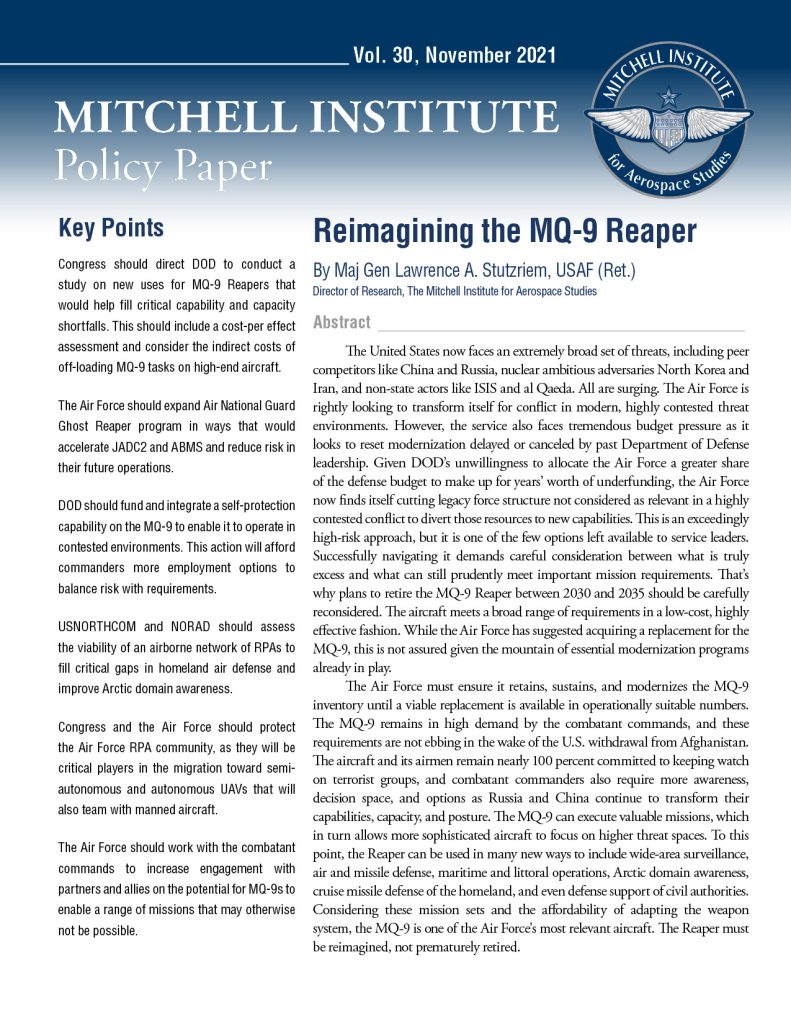Arlington, VA | November 18, 2021 — The Mitchell Institute for Aerospace Studies is pleased to announce a new entry in its Policy Paper series, Reimagining the MQ-9 Reaper by Maj Gen Lawrence A. Stutzriem, USAF (Ret.), Director of Research at the Mitchell Institute.
The United States now faces an extremely broad set of threats, including peer competitors like China and Russia, nuclear ambitious adversaries North Korea and Iran, and non-state actors like ISIS and al Qaeda. All are surging. The Air Force is rightly looking to transform itself for conflict in modern, highly contested threat environments. However, the service also faces tremendous budget pressure as it looks to reset modernization delayed or canceled by past Department of Defense leadership. Given DOD’s unwillingness to allocate the Air Force a greater share of the defense budget to make up for years’ worth of underfunding, the Air Force now finds itself cutting legacy force structure not considered as relevant in a highly contested conflict to divert those resources to new capabilities. This is an exceedingly high-risk approach, but it is one of the few options left available to service leaders. Successfully navigating it demands careful consideration between what is truly excess and what can still prudently meet important mission requirements. That’s why plans to retire the MQ-9 Reaper between 2030 and 2035 should be carefully reconsidered. The aircraft meets a broad range of requirements in a low-cost, highly effective fashion. While the Air Force has suggested acquiring a replacement for the MQ-9, this is not assured given the mountain of essential modernization programs already in play.
The Air Force must ensure it retains, sustains, and modernizes the MQ-9 inventory until a viable replacement is available in operationally suitable numbers. The MQ-9 remains in high demand by the combatant commands, and these requirements are not ebbing in the wake of the U.S. withdrawal from Afghanistan. The aircraft and its airmen remain nearly 100 percent committed to keeping watch on terrorist groups, and combatant commanders also require more awareness, decision space, and options as Russia and China continue to transform their capabilities, capacity, and posture. The MQ-9 can execute valuable missions, which in turn allows more sophisticated aircraft to focus on higher threat spaces. To this point, the Reaper can be used in many new ways to include wide-area surveillance, air and missile defense, maritime and littoral operations, Arctic domain awareness, cruise missile defense of the homeland, and even defense support of civil authorities. Considering these mission sets and the affordability of adapting the weapon system, the MQ-9 is one of the Air Force’s most relevant aircraft. The Reaper must be reimagined, not prematurely retired.
The Mitchell Institute Policy Papers is a series presenting new thinking and policy proposals to respond to the emerging security and aerospace power challenges of the 21st century. These papers are written for lawmakers and their staffs, policy professionals, business and industry, academics, journalists, and the informed public.
For media inquiries, email our publications team at publications.mitchellaerospacepower@afa.org
Copies of Policy Papers can be downloaded at https://www.mitchellaerospacepower.org/publications
